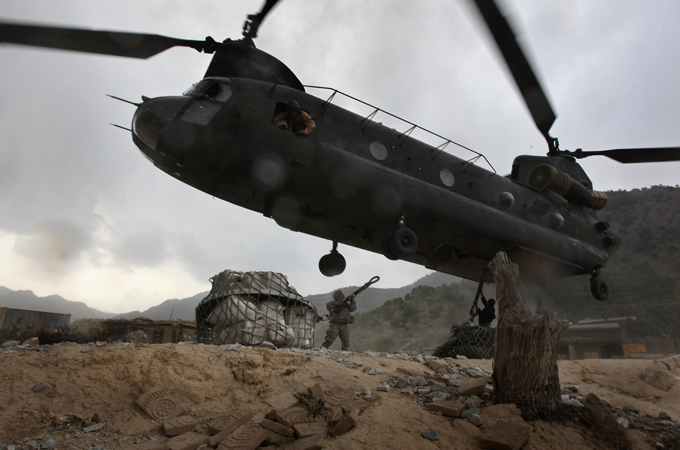Afghan helicopter crash kills NATO troops
Incident in Helmand follows deaths of seven civilians in suicide attack outside US and NATO air base in Kandahar.

 |
| Thursday’s helicopter crash occurred on the same day as a suicide bombing in Kandahar killed seven [GALLO/GETTY] |
A NATO helicopter has crashed in southern Afghanistan, killing six American soldiers, US officials say.
In a brief statement, NATO’s International Security Assistance Force, or ISAF, said early on Friday that there was no enemy activity in the area at the time of the crash on Thursday night.
Keep reading
list of 4 items‘Mama we’re dying’: Only able to hear her kids in Gaza in their final days
Europe pledges to boost aid to Sudan on unwelcome war anniversary
Birth, death, escape: Three women’s struggle through Sudan’s war
The cause of the crash is still being investigated, NATO said.
The helicopter, a CH-53 Sea Stallion, went down in Helmand province, one US official who asked not to be named told the AFP news agency. The official confirmed the dead were members of the US military.
The Sea Stallion is a heavy transport aircraft capable of carrying about 40 people. US officials did not say whether anyone else other than the six victims was on board,
In August, Taliban fighters shot down a US Chinook helicopter, the most deadly incident for US and NATO forces since the war in Afghanistan began in 2001
Thirty US soldiers were killed in the attack, including 17 Navy SEALs and five other Navy sailors assigned to the SEAL unit. Seven Afghan troops and an interpreter were also killed.
Suicide bombing
Thursday’s helicopter crash occurred on the same day seven civilians were killed outside a crowded gate at Kandahar Air Field, a base for US and NATO operations, after a suicide attacker set off a vehicle laden with explosives.
Eight people, including two civilians and two Afghan soldiers were wounded in the incident near the entrance of the Kandahar airport, provincial spokesman, Zalmay Ayoubi told local Afghan media.
The Taliban claimed responsibility, saying they were targeting a NATO convoy.
It was the second suicide bombing in as many days in southern Afghanistan, officials said. ISAF said no NATO troops were killed. It does not disclose information about injured troops.
Two witnesses have told the Associated Press news agency that they suspect the suicide car bomber was trying to hit US forces because he detonated his explosives just as two pickup vehicles, which they say are often used by US special forces, were leaving the base.
Qari Yousef, a Taliban spokesman, said NATO forces opened fire after the bombing, and that they killed three of the seven civilians who died. ISAF denied this, saying there was no fighting after the blast.
Earlier, officials reported that the suicide bomber was walking near the gate, but the Afghan interior ministry later said the attacker was driving a Toyota Corolla.
Children among dead
Zalmai Ayubi, the spokesman for the Kandahar provincial governor, said two children were among the seven civilians killed. He said eight other civilians, including two children and one woman, were injured in the explosion.
Gates to the larger US bases in Afghanistan often are crowded with vehicles waiting to deliver goods and services, and local Afghans going to or coming back from jobs on the compounds.
In an attack on Wednesday, 13 civilians, including three Afghan policemen, were killed when a suicide attacker blew himself up in a bazaar in neighbouring Helmand.
The Helmand governor’s office said 22 others were wounded in the blast in Kajaki district.
ISAF said some international troops were killed and wounded in the attack, but did not disclose details.
Late on Wednesday, NATO reported that one soldier had been killed in an explosion in southern Afghanistan, but would not say whether the service member died in the Kajaki bombing, or some other incident.
Avalanche deaths
In northern Afghanistan, 29 people have died in avalanches reported since Monday in Badakhshan province. according to the Afghan National Disaster Management Agency.
At least 40 more people have been injured and rescuers were struggling to reach areas of Afghanistan’s mountainous northeast that have been cut off by heavy snows.
Roads outside the provincial capital of Faizabad were blocked by at least 6ft of snow, the agency said.
Afghanistan’s harsh winters and mountainous terrain in the north make avalanches a danger each year.
In February 2010, an avalanche killed at least 171 people near the Salang Pass, a major route through the Hindu Kush mountains that connects the capital of Kabul to the north of the country.